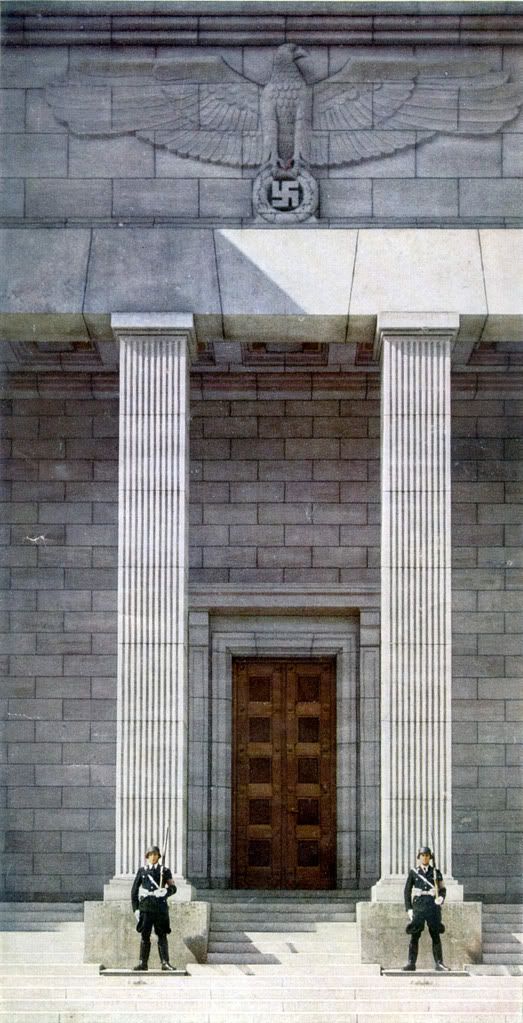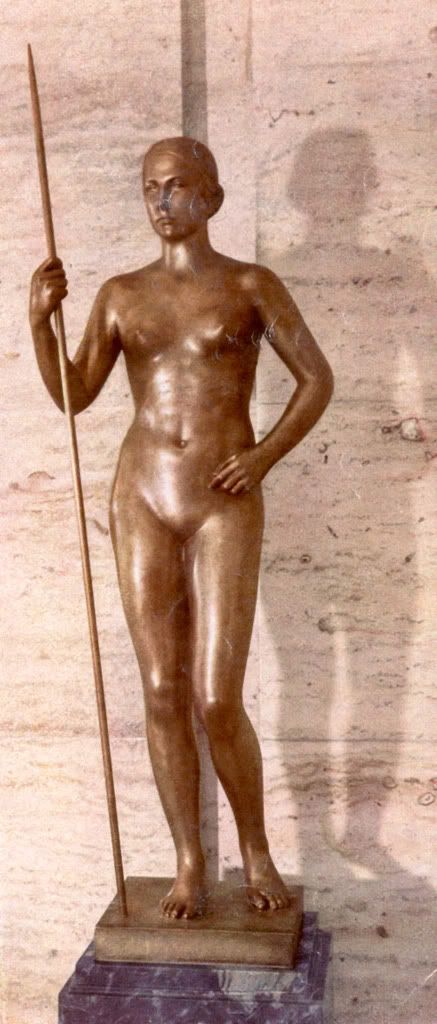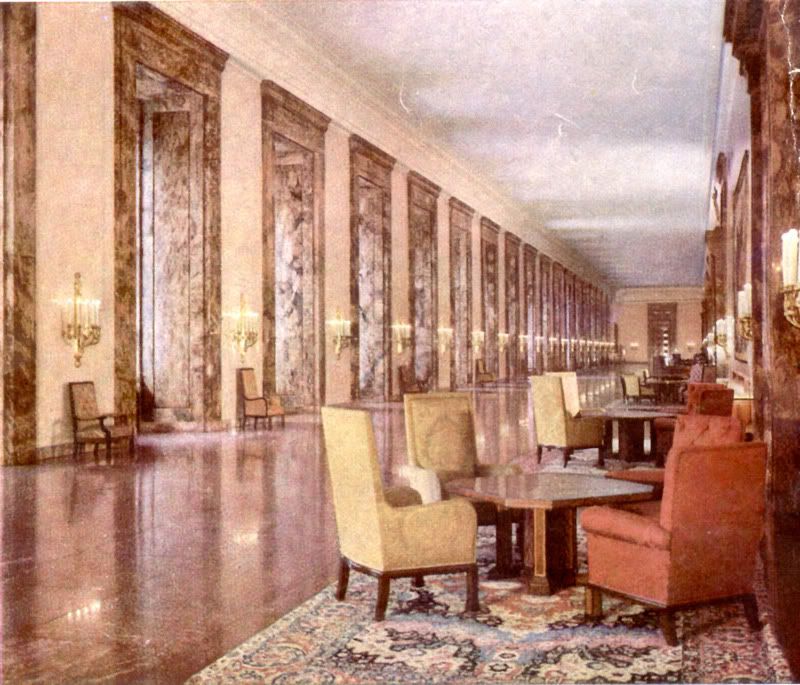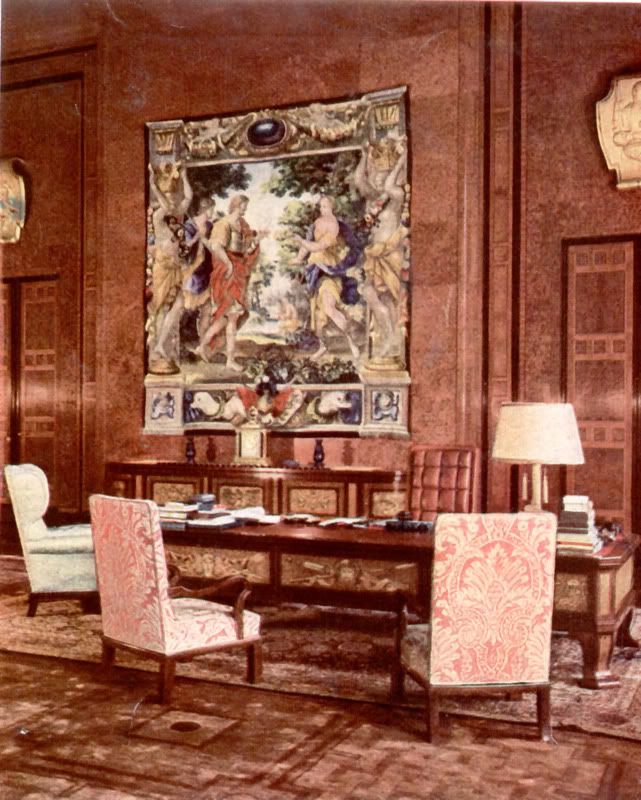




Indeed magnificent snapshots – Coup de chapeau à Monsieur Coen! 
I shall take this opportunity to pay additional color photo-tribute to this remarkable building - the New Chancellery of the Reich (Die Neue Reichkanzlei) – which was designed by Albert Speer.
All these snapshots are originating from the renowned German “Signal” magazine.

[b]Wom Hoheitszeihen Des Großdeutchen Reiches gekrönt: Das Westportal der Reichskanzlei in der Voßstrasse – SS Männer halten Wache davor
Crowned by the national Amblems of the Great German Empire: the Western Portal of the Imperial Chancellery in the Voßstrasse – SS men are holding a watch in front of it[/b]

Der Runde raum - The Rotunda
Once again – thank you for this opportunity, my dear Mr. Koen! 
Fantastic pics! Librarian, is this from your new scanner that you talked about?
No, my dear Mr. Admin – these pictures are representing results of the unreserved activity conducted by my Old Faithful HP Scan Jet 3300 C. But don’t worry: in a week or two Hitler’s study will be the first “gigantic one” that will be posted here. You will be able to see even those artistic details offered by the magnificent Lenbach’s picture “Bismarck” on the wall! That’s a guarantee! 
However, here we have some other magnificent captions offered by “Signal” back there in 1941:

Ein schmales Portal aus Bronze führt von der Vorhalle in den Mosaiksaal - A narrow portal made out of bronze leads from the Entrance hall into the Mosaic hall
Another, almost completely ignored fact connected with the new imperial chancellery is the verity that different artistic sculptures completed by Breker, Fehrle, or Klimsch were used as distinctive decorative elements for the interior. Those exceptionally striking and geometrically perfective naked bodies, with their fine and extended, well-proportioned, almost idealized parts, are absolute eye-catchers for every observer inclined toward the classicistic tradition.

Arno Breker: Diana, die Jagdgöttin - Diana: The Goddess of the Hunt
To be continued… 
Librarian.
You should post some of these pictures on the main gallery of this website by clicking the UPLOAD A PHOTO tab. More people check that gallery than they do this forum.
Nice scans. Thanks.
Oh, not at all, my dear Mr. Admin – as a matter fact, I am getting pleasure from this commitment! And please, don’t be troubled – without more ado I shall try to accomplish your suggestion. 
However, I have to call your attention to the fact that certain pictures are truly colossal ones…
But never mind that – back to our contemporary subject:

Die “Lange Halle” der Reichskanzlei. Die Marmorgalerie ist 146 meter lang. - The “Long Hall” of the Imperial chancellery. The Marble gallery is 146 meters long.

Blick auf den Schreibtisch des Führers von vorn. An der Wand hängt ein Gobelin aus dem XVII Jahrhundert - View toward the writing desk of the Fuhrer, from ahead. A XVII century gobelin tapestry is hanging on the wall.
To be continued soon…
In the meantime, as always - all the best! 
Great images, thank you for sharing, it sure was an impressive place - and more spacious than my hut ;-D
It would be interesting to know what foreign visitors (really) thought about it - some of them of course could not publicly praise/admire it (I recall reading that soviet diplomat Berezkov thought it wasn’t attractive) - but it must have made a deep impression to most.
_
As i understand it was black-white photos that was colored after the war?
Or was it originally color photos?
These were really taken in color, not hand drawn. However, the quality of the photos are even better than what you see here! I’ve seen some physical copies of the photos that the Germans used in SIGNAL magazine and when you compare them to the magazine and to the real copy, the differences are incredible. The slides look as if they were shot today.
Oh, not at all, my dear Mr. Aleph – you know, as a professional Librarian I really do believe that by finding a piece of historiographic information, by making aforesaid piece publicly available and by putting it into valid scientific context we will be able to start off another search for more information! 
History, in order to become a science devoted to growth of a man, must be able to make valuable, objective and unrestrained comparisons. It will be able to do that if and only if sufficient amounts of basic, original historiographic material are available to everyone, by making historical events more and more common. To borrow Abraham Lincoln’s utterly truthful phrase “If we could first know where we are, how we arrived here and whither we are tending, we could better judge what to do and how to do it.” That’s all.
And yes, you are absolutely right, my dear Mr. Aleph – due to those truly horrific events which unfortunately occurred in Europe, certain aspects of the Third Reich - architectural achievements for example - were subsequently almost obligatorily discussed with some kind of… enforced dichotomy. Strict and stringent artistic (architectural, sculptural, pictorial, etc.) categories were valuated as objects of appropriate moral disclosure, and not as objects of skill, talent and artistic imagination. Of course, the new Imperial Chancellory is not an exception.
However, as far as I know, the most sincere expression of a personal artistic feeling, outspoken by a prominent foreign representative toward certain architectonic constructions in the Third Reich, was completed by a French diplomat André François-Poncet. When the ex-French Ambassador to Germany went to the Bavarian Alps as the official representative of his country, he visited the Führer’s astounding new personal retreat - the Adlerhorst (Eagle’s Nest). Filled with admiration, he described the building as “…an observatory floating in space, perched like an eagle’s nest, a castle of the Grail, … Mount Athos”.
I have to admit that I was similarly impressed when I analyzed Hitler’s personal Mercedes 770 K Führerwagen. But that’s a completely different story… 
http://aolsvc.timeforkids.kol.aol.com/time/magazine/article/0,9171,760910,00.html
As i understand it was black-white photos that was colored after the war?
No, my dear Mr. Chevan – actually the main problem is connected with obtainable printing techniques and available paper quality in those times. You see, even today available prints are highly dependant upon five main characteristics of paper – caliper, gloss finish, matte finish, opacity and permeability. Briefly – the main problem connected with clarity of photos occurred due to porous nature of the paper, which caused haziness on the stamped picture. Furthermore, in those times every color printing was printed with so called Process printing technique, which used four transparent inks - blue, red, yellow, and black - printed one on top of another in varying amounts. Each time printing drum had to overlay given spot on the very same place. If this prerequisite was not achieved due to mechanical distortion of paper, stamped picture was vague and unstained.
And now - as promised – here we have another picture from the famous German “Signal” magazine, which is connected with the New Imperial Chancellery:

Die Tür zum Arbeitszimmer des Führers. Sie ist sechs Meter hoch, aus Mahagoniholz und deutschem Marmor gebaut und mit den Initialen A. H. geschmückt. - The door to the study of the Fuehrer. It is six meters high, constructed out of mahogany wood and German marble and decorated with the initials “A. H.”
BTW: The next picture within this color serial definitely will be a very huge one. 
In the meantime, as always – all the best!
Hi Librarian,
Any chance you would be able to post further pictures? The construction work is really fascinating. (That is what I do.)
Beautiful
